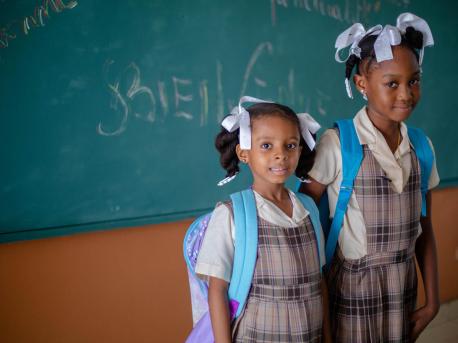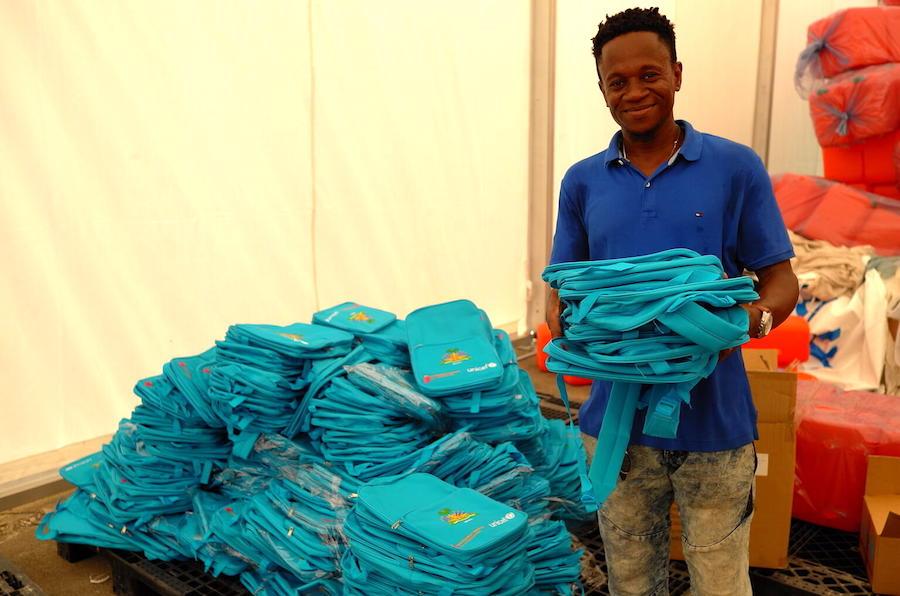
Getting Students Back to School in Haiti After an Earthquake
Almost two months after a devastating earthquake hit Haiti, about 70 percent of all schools in the southwestern part of the country are still either damaged or destroyed. UNICEF and partners are working to help students get back to learning as quickly as possible.
As part of the back-to-school campaign launched on October 4, 2021, about 300,000 children are starting to gradually resume schooling in the three earthquake-stricken departments: South, Grand'Anse and Nippes.

UNICEF is distributing educational and recreational materials in areas affected by the earthquake. About 100,000 children will receive their own UNICEF backpacks full of supplies as they gradually return to the classroom in the coming days and weeks. In partnership with the Haitian Government, UNICEF will also help provide mental health and psychosocial support to students and teachers, as well as incentives for teachers.

“I am shocked to see how many schools were flattened or damaged due to the earthquake,” said Bruno Maes, UNICEF Representative in Haiti. “The extent of the damage to school buildings is worse than we initially thought. Repairing or rebuilding these schools will take time and resources. However, with or without schools, learning and teaching must continue. The longer children wait, the more difficult it will be to get them back to school.”
For ten-year-old Beland, above, the earthquake seemed like "the end of the world." She's eager to get back to the classroom — being in school means an important return to normalcy, a safe place to learn and play.

The earthquake has already delayed school reopening by a month. If classrooms remain closed, UNICEF estimates that more than 230,000 children are at risk of dropping out of school in the departments affected by the earthquake.
The initial phase of the reconstruction work has begun at some schools destroyed on August 14, 2021. Progress is expected to accelerate in the coming weeks. About 150 new schools will be rebuilt and 900 temporary learning spaces will be set up.

Together with the Ministry of Education, UNICEF is exploring several strategies to cope with the reduced number of classrooms currently available for teaching. For instance, schools that are still functional will host students from destroyed schools and operate in double shifts.

“Amidst the current turmoil in Haiti, going back to the classroom in earthquake-stricken areas means much more than just resuming learning,” said Maes. “School is where children reconnect with their friends, overcome trauma and return to normality through play. This very first day at school in southwestern Haiti is the beginning of a new chapter in the life of children affected by the earthquake, a sign of hope and joy for them and their parents."
In response to the earthquake, UNICEF is urgently seeking $25.5 million to build new schools, repair the damaged ones and meet the immediate education needs of affected children. So far less than 20 percent of this required funding has been received. Please donate.
Top photo: Jasmine and Anise are excited to be starting school on October 4, 2021 at Saint-Anne School in Les Cayes, Haiti. The first day of school was postponed following Haiti's devastating August 14, 2021 earthquake. © UNICEF/UN0532224/Rouzier
HOW TO HELP
There are many ways to make a difference
War, famine, poverty, natural disasters — threats to the world's children keep coming. But UNICEF won't stop working to keep children healthy and safe.
UNICEF works in over 190 countries and territories — more places than any other children's organization. UNICEF has the world's largest humanitarian warehouse and, when disaster strikes, can get supplies almost anywhere within 72 hours. Constantly innovating, always advocating for a better world for children, UNICEF works to ensure that every child can grow up healthy, educated, protected and respected.
Would you like to help give all children the opportunity to reach their full potential? There are many ways to get involved.



